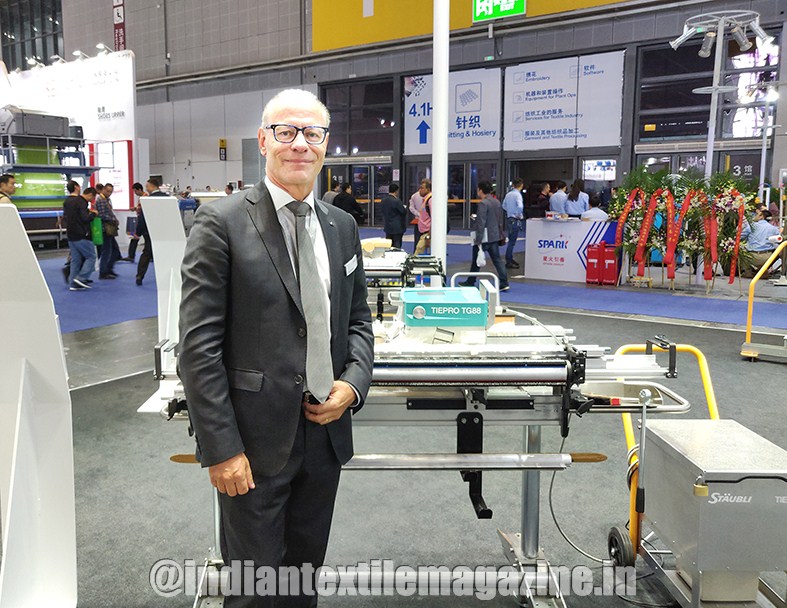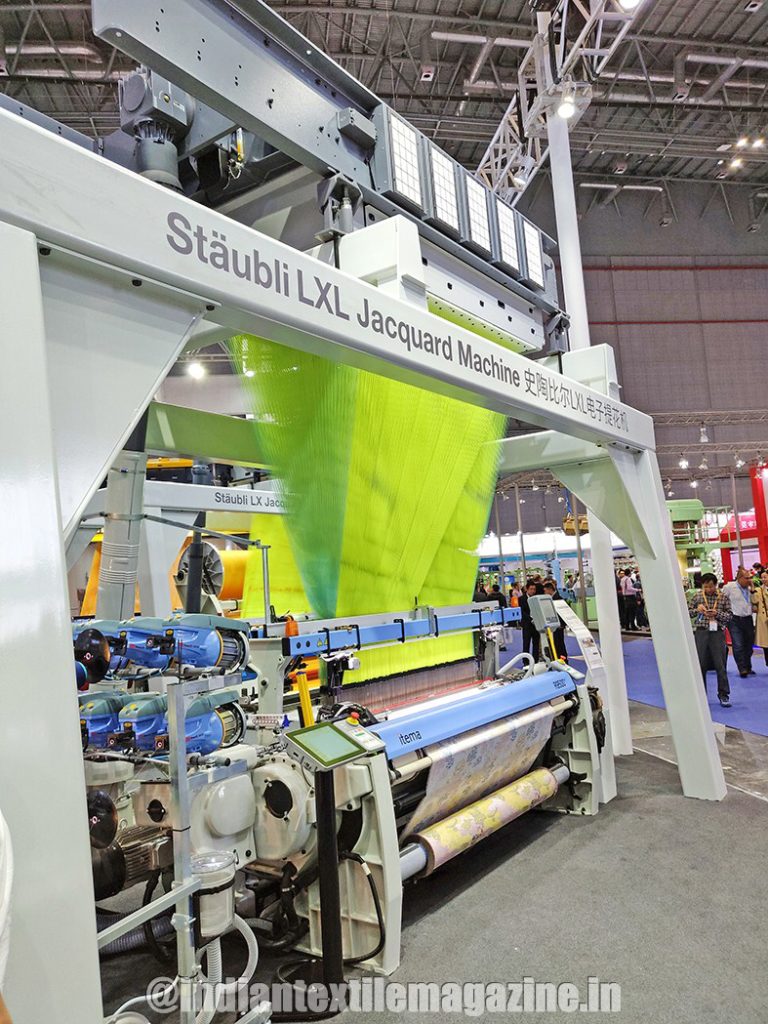Fritz LEGLER – Vice President Marketing, Sales & Service, Stäubli
The year 2018 has been a tricky one for global trade, with the super powers on trade war yet to arrive at a concrete solution. Has this impacted business globally?
The influence of these ‘super power’ countries is critical on the global business behavior. It can be observed in all industries, and for sure as well in the global textile business. However, the impact is not completely felt yet, since some of the actions taken have not fully filtered through yet. It is absolutely clear that disturbances like that create uncertainties in the market place.
Do you see a significant shift or the beginning of a revival in manufacturing in the US and European countries, particularly for textiles?
A significant shift, revival or in-shoring as some call it, might be wordings that are too strong, but within the global situation certain production segments might take advantage if market distortions eventually take their toll. There is clearly a rethinking taking place – some production plants are not even shifted anymore, to start with. Many topics have to be considered these days – not only labor costs or taxes are the big thing, but also transport or quality issues, currency distortions, and so forth.
With increased automation in textile manufacturing and ever-increasing demand for high quality and sustainably manufactured products, do you think low cost labor can no longer be an advantage?
Labor is always an issue if it comes to textile manufacturing – minimum wages are being introduced in many economies. This may be reason enough to relocate production plants. On top of that, quality aspects gain further importance, as do sustainability issues.
Labor is very often not fully available any more or people find better jobs than in textile manufacturing – automation – like for instance our textile robots (e.g., automatic drawing-in machines of the SAFIR line) therefore come in handy. Fabric styles and repeats get more and more delicate and difficult, which makes it harder on manual labor – again a clear reason for total automation, thus fostering the use of fully automatic drawing-in machines which take away most of manual labor.
How was 2018 for Stäubli?
Stäubli Textile enjoyed a good level of business around the globe for most of the year – the result being fully in line with our expectations. Many new products were launched in recent years and during 2018 – innovation being a driving force within our company. This helped us to stay ahead of the curve – be it for shed forming solutions like dobbies, cam motions or jacquard machines or our automation solutions with fully automatic drawing-in machines.
Can you name 3 significant highlights for Stäubli in 2018?
After a successful 2017 highlighted by our 125 years celebrations, 2018 was another very important year for the whole group. In June the Stäubli Group announced the acquisition of the German RS Roman Seliger Armaturenfabrik GmbH. This acquisition is in line with the company’s successful growth strategy and concerns particularly the Connectors activity of the Group. It allows joining innovative forces in new complementary fields such as big diameter couplings, breakaway technologies and cryogenics.
Right after that, in August, Stäubli announced the acquisition of a 70 per cent stake in WFT GmbH & Co. KG, based as well in Germany. WFT has been a specialist in the construction of special-purpose machines and mobile platforms for two decades. This acquisition allows the Stäubli Robotics activity joining innovative forces in new complementary fields such as the autonomous guided vehicle (AGV) and automation add-ons.
For Stäubli Textile, the highlight was this year’s ITMA Asia / CITME where we could once again underline our leading position and get positive feedbacks about all our offerings from the markets.
Can you name the key global markets and potential emerging markets in which Stäubli performed well during 2018?
The key markets performing well were China, India and the neighboring Asian countries. Turkey was a strong market as well before it got hit by political, structural and currency issues.
At ITMA Asia, Stäubli launched the BEAMPRO, automation for warp preparation of colored warp sheets. What was the reason for Stäubli to develop this technology? What is the current challenge in this process and how does BEAMPRO help overcome this challenge?
As a leading company known for being an automation specialist in warp preparation, Stäubli wants to innovate continually in order to bring even more benefits to textile mills. Mastering warp yarns, layers or warp sheets, as well as color and yarn structure repeats is one of the important know-how aspects of Stäubli weaving preparation solutions.
Starting the automation and preparation process now already at sizing machines – and not just afterwards – was a request of the industry since there is still a lot of manual labor involved when it comes to manual reading-in of color yarns of beam dyed split beams on sizing machines. Up to four people read-in yarns into combs on sizing machine prior to the actual sizing process which can take a long time – our BEAMPRO automates this process and reduces the idle time of a sizing machine. The quality of sized color beams thus improves and helps speed up subsequent processes in warp preparation.
When are you planning to start commercial installations of BEAMPRO?
Several BEAMPRO reading-in machines are already running successfully in a commercial sizing operation – and the new machine is fully available now. It was successfully launched and appreciated by the market at ITMA Asia.
Stäubli also unveiled the large format LXL Jacquards. How important is this launch for Stäubli? How do you expect demand for these machines and which are the segments that would drive demand?
At ITMA Asia we presented the LXXL model to weaving mills. This very compact Jacquard machine is available in formats up to 25,600 hooks (51,200 in tandem set-up). The segments that pushed us for developing are mainly high end dense clothing fabrics, big format designs, but as well upholstery.
Overall how was the mood at ITMA Asia? What are the key takeaways for Stäubli?
Stäubli was busy and could register important visits from key or prospective customers. However, the overall visitor number to the general exhibition was lower than for the 2016 edition. Our main takeaways were the positive feedbacks about our product developments and that they are in line with the current market needs.
Visitors to the exhibition saw a huge number of weaving machines featuring Stäubli cam motions, electronic rotary dobbies or jacquard machines.
Coming to India, with demonetization and the GST roll-out behind us, how was the year 2018 for Stäubli?
It was like “business as usual” for us – investments into new weaving technology progressed as per our expectations and without any big shifts from the previous years. There will have to be some stability and longer runs without any further market distortions for our customers to become more positive about further investments. The looming elections may slow down market activity for some months to come.
Do you expect the investment cycle to pick up in 2019? What are your thoughts on the future potential of the Indian market?
As hinted at, there are no big investment swings to be seen in India right now. Machinery sales have been constant for some years now – with only little up- or downward moves. It goes without saying that many of us believe that India has much more potential to further grow its textile industry – and we really hope that the country will find a way to fully profit from its strength in future.
Stäubli is undoubtedly the pioneer in weaving, and preparation technology, driving most of innovation and setting benchmarks in this segment. How does Stäubli constantly challenge itself to move itself and the industry to the next level?
Customer expectations for a market leader like Stäubli Textile are high. Stäubli is rooted in a proud heritage of engineering and innovation. We are also a forward-thinking organization, on a continual quest for the next great innovation that will help our customers work more productively, efficiently and sustainably. Passion for innovation, our moto in 2017 for our 125-year celebrations, may resume it at its best.
Finally, 2019 promises to be an exciting year with the all-important ITMA Barcelona. What are your expectations in 2019 globally? Do you expect the trade war to settle down and see more clarity in global trade?
In 2019 Stäubli Texile focuses on ITMA Europe which remains the show to present novelties. We think that 2019 will be a more difficult business year compared with earlier years. Nevertheless, we still remain positive and hope that our exhibits at ITMA will prove yet another time that we care about the market needs and that our customers will appreciate the novelties.
Finally, what can we expect from Stäubli at ITMA 2019? Let’s keep the level of surprise a little longer – shall we?
We will certainly unveil first information in spring 2019 during the SWISSMEM pre-ITMA event in Switzerland. Thank you for your understanding that we keep you and your readers guessing for a little longer. Spring time 2019 is around the corner.

